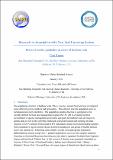Files in this item
Research in association with New Seal Licensing System : research on the population structure of harbour seals
Item metadata
| dc.contributor.author | Islas Villanueva, Valentina | |
| dc.contributor.author | Hall, Ailsa Jane | |
| dc.contributor.author | Graves, Jefferson Alden | |
| dc.date.accessioned | 2022-11-23T11:30:01Z | |
| dc.date.available | 2022-11-23T11:30:01Z | |
| dc.date.issued | 2012-01-31 | |
| dc.identifier.citation | Islas Villanueva , V , Hall , A J & Graves , J A 2012 , Research in association with New Seal Licensing System : research on the population structure of harbour seals . | en |
| dc.identifier.other | PURE: 282271072 | |
| dc.identifier.other | PURE UUID: a15b9735-42de-4557-8011-02da66ce5c30 | |
| dc.identifier.other | ORCID: /0000-0002-7562-1771/work/123613706 | |
| dc.identifier.uri | https://hdl.handle.net/10023/26471 | |
| dc.description.abstract | The population structure of harbour seals (Phoca vitulina) around Scotland was investigated using different genetic markers and approaches. This allowed discrete population units or metapopulations to be identified. The population genetic structure is compared to the recently defined harbour seal management regions (SCOS, 2011), ensuring Scottish Government’s regional management procedures and plans for harbour seals are based on genetic data as well as the currently employed ecological haulout and pupping site data. Analysis of DNA samples from a total of 453 individuals around Scotland including samples from comparative regions in the UK and Europe (including an out-group of Pacific harbour seals) was carried out. Following some initial trials the most appropriate population differentiation analysis comprised 10 putative populations across all the samples analysed. Focusing on Scotland, Bayesian clustering analysis clearly separated Scotland from England, France and the Dutch Wadden Sea. In this scenario 3 clusters were generally identified: a) Norway, b)West Coast of Scotland/Northern Ireland and c) Pentland Firth / Orkney / Shetland / Moray Firth / Tay and Eden with some degree of shared individuals between them. Examining the Scottish populations alone indicated there might be some additional separation between the Tay and Eden compared to the other north and east coast groups. Within the Scottish populations a number of harbour seal Management Areas have been assigned based on haul outs and breeding sites (SCOS, 2011). The result of the genetic analyses reported here clearly supports the designation and definition of these Areas. Allelic diversity and heterozygosity are standard measures that assess the level of inbreeding which populations display as a reflection of their ‘genetic health’. The populations with relatively good sample sizes and low levels of genetic diversity were Shetland (n=2.545, HO=0.363) and the Outer Hebrides (2.467, HO= 0.331). It has been widely shown that inbreeding, translated as very low levels of genetic diversity in wild populations is correlated with disease such as cancer (Acevedo-Whitehouse et al. 2003) and with susceptibility to pathogens such as parasites (Rijks et al. 2008) among others. | |
| dc.format.extent | 25 | |
| dc.language.iso | eng | |
| dc.rights | Copyright © 2022 the Author(s). This work has been made available online in accordance with publisher policies or with permission. Permission for further reuse of this content should be sought from the publisher or the rights holder. This is the final published version of the work. | en |
| dc.subject | GC Oceanography | en |
| dc.subject | QH301 Biology | en |
| dc.subject | SDG 3 - Good Health and Well-being | en |
| dc.subject | MCC | en |
| dc.subject | NCAD | en |
| dc.subject.lcc | GC | en |
| dc.subject.lcc | QH301 | en |
| dc.title | Research in association with New Seal Licensing System : research on the population structure of harbour seals | en |
| dc.type | Report | en |
| dc.description.version | https://doi.org/Publisher PDF | en |
| dc.description.version | https://doi.org/Publisher PDF | en |
| dc.contributor.institution | University of St Andrews. Scottish Oceans Institute | en |
| dc.contributor.institution | University of St Andrews. School of Biology | en |
| dc.contributor.institution | University of St Andrews. Sea Mammal Research Unit | en |
| dc.contributor.institution | University of St Andrews. Marine Alliance for Science & Technology Scotland | en |
This item appears in the following Collection(s)
Items in the St Andrews Research Repository are protected by copyright, with all rights reserved, unless otherwise indicated.


